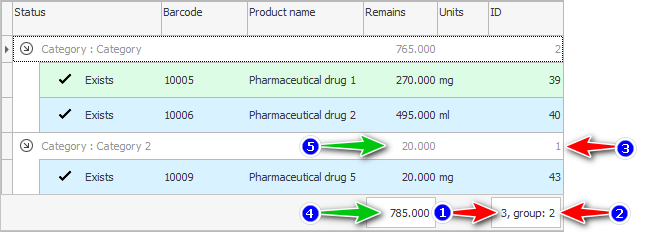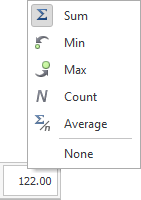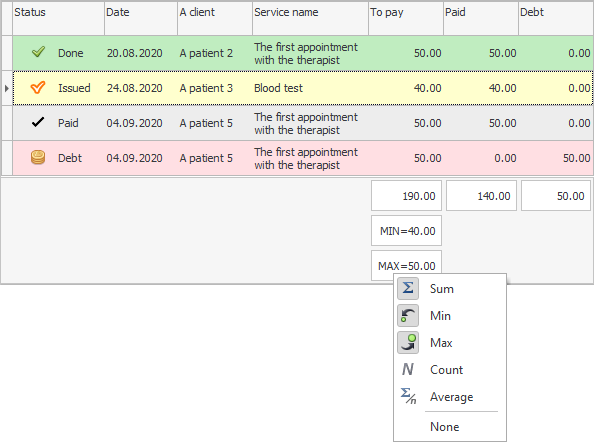
The program automatically calculates the number of records in the table and the sum of the numeric fields. If we go, for example, to the directory "nomenclature" medical goods and supplies, and then "let's deploy" ![]() grouped records , we will see something like this.
grouped records , we will see something like this.

At first "display" , please, the column with the record ID ID , because by default this field is in the hidden list. But now we need it.
How to display, place it last, so that it turns out like we have in the upper picture.
![]() And here you can read in detail about what kind of field this 'ID' is.
And here you can read in detail about what kind of field this 'ID' is.
Now look, please, in the upper picture at the first arrow. It shows the number of entries . In the table we now have 3 different products .
The second arrow points to the number of groups . This indicator appears only if applied ![]() grouping data in a table.
grouping data in a table.
It is noteworthy that information can be grouped by any field. In this case, our products are grouped by "Product categories" . There are two unique values in this field, according to which 2 groups are created.
The third arrow shows the number of entries in each product group . In our figure, the red arrows show exactly the amount.
And the green arrows indicate the amounts. The fourth arrow sums up all the values in the field "The rest of the goods" .
In this example, we have all products "measured" in pieces. But, if there are motley goods with different units of measurement, then this amount can already be ignored. Since there will be no sense when adding, for example, 'pieces' and 'meters'.
But! If the user applies ![]() filtering the data and displaying only the product that will have the same units of measurement, then again you can safely use the calculated amount from the bottom of the field. It all depends on different life situations.
filtering the data and displaying only the product that will have the same units of measurement, then again you can safely use the calculated amount from the bottom of the field. It all depends on different life situations.
The fifth green arrow points to the group sum .

By default, the amount is always calculated below the numeric fields, and the number of records is always calculated below the ' ID ' system field. If you right-click on the area in which the totals are calculated at the bottom of the table, you can change the calculation method.

Thus, you can immediately see the minimum value for any column, and the maximum value . And even calculate the arithmetic mean .
Even if in the standard configuration the totals for some column are not calculated, you can easily get the total for the desired field manually.
It is noteworthy that the calculation of totals can be applied not only to a numeric field, but also to a field of type ' Date '. For example, it is so easy to find out the maximum or minimum "date of birth" . This means that it is easy to identify the youngest or the oldest client.

It is possible to display several total values at the same time. The following example shows how, in addition to the amount of checks, to find out the amount of the minimum and the amount of the maximum check.


![]() According to the calculated results, it is even possible
According to the calculated results, it is even possible ![]() sort grouped rows .
sort grouped rows .
See below for other helpful topics:
![]()
Universal Accounting System
2010 - 2024